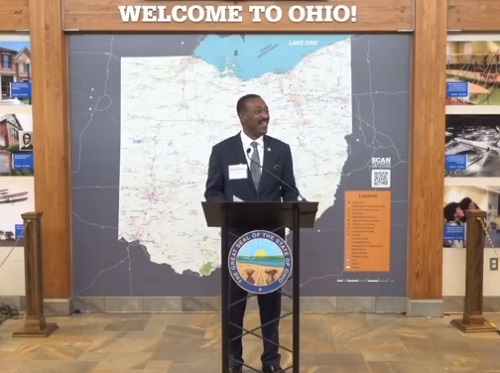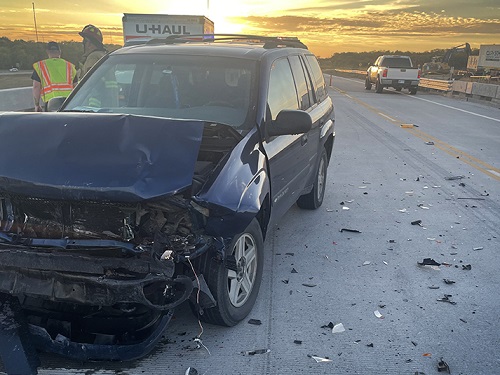The National Highway Traffic Safety Administration estimates that 19,515 people died in motor vehicle traffic crashes in the first half of 2023; a decline of 3.3 percent compared to 20,190 fatalities in the first half of 2022.
[Above photo by the Kansas DOT]
Those figures track with estimates released by the National Safety Council in early September.
NHTSA added that traffic fatalities have now declined for five straight quarters, even as vehicle miles traveled or VMT continues to increase.
The agency noted that its preliminary data shows VMT in the first half of 2023 increased by about 35.1 billion miles or roughly 2.3 percent compared to the first half of 2022 – and more miles driven combined with fewer traffic deaths resulted in a fatality rate of 1.24 fatalities per 100 million VMT, down from the projected rate of 1.31 fatalities per 100 million VMT in the first half of 2022.

[Editor’s note: The American Association of State Highway and Transportation Officials 2023 Safety Summit takes place in Kansas City October 17-19. That summit is being held in conjunction with a joint meeting of AASHTO’s Committee on Safety, Council on Active Transportation, and Committee on Planning, which will meet after the event concludes to craft a “safety action plan” designed to advance safety consistently throughout the transportation project development lifecycle and across the functions and services of state departments of transportation.]
NHTSA’s data also marked a decrease in traffic fatalities in 29 states, while 21 states, Puerto Rico, and the District of Columbia, are projected to have experienced increases during the first half of 2023 compared to the same six-month period in 2022.
“While we are encouraged to see traffic fatalities continue to decline from the height of the pandemic, there’s still significantly more work to be done,” NHTSA Acting Administrator Ann Carlson noted in a statement.
“NHTSA is addressing traffic safety in many ways, including new rulemakings for lifesaving vehicle technologies and increased … funding for state highway safety offices,” she added. “We will continue to work with our safety partners to meet the collective goal of zero fatalities.”
State DOTs have been engaged in a number of efforts since the start of 2023 to reduce the number of traffic fatalities across the country.
For example, in August, Governor Mike DeWine (R) and the Ohio Department of Transportation highlighted the investment of $61 million in funding for 27 new traffic safety projects in numerous counties statewide. That round of funding from the Ohio DOT’s Highway Safety Improvement Program includes the installation of Restricted Crossing U-Turns or RCUTs, roundabouts, sidewalks, and other safety measures.

The agency is also studying a range of safety improvements for the U.S. 23 Corridor; a major connector for economic activity in Northwest Ohio.
“Our engineers have been working to improve travel along the U.S. 23 corridor for several years now. While we’ve made improvements, more clearly needs to be done,” said Ohio DOT Director Jack Marchbanks in a statement.
“We’ll be engaging the public in the coming months to ensure that those who live, work, and travel here have a voice in its future,” he said.
In July, the Kansas Department of Transportation helped launch a new five-year Safety Corridor pilot program to reduce fatalities and serious injuries along specific stretches of four major interstates. Increased law enforcement, traffic safety education campaigns, low-cost engineering improvements and a review of emergency response issues are part of the comprehensive approach of the program’s goals.
To address the rising number of fatalities on California roadways, the California Office of Traffic Safety launched the “Go Safely Movement” campaign in May with the help of the California State Transportation Agency, California Department of Transportation, and California Highway Patrol.
Additionally, AASHTO hosted a knowledge session – sponsored by HDR – at its 2023 Spring Meeting in Seattle that detailed the vital role state DOTs play in achieving zero roadway fatalities across the United States.
“It really has to be a collaborative and national effort; we can no longer just worry about what’s happening in our own backyard,” explained session moderator Bernie Arseneau, highways and roads director for HDR, at that session.
“We also need to shift from a reactive to a proactive stance when it comes to reducing roadway fatalities – and that is not an easy shift to make; it’s one with a lot of challenges,” he added. “It really means we must incorporate safety into every part of the transportation project cycle now.”
 Top Stories
Top Stories
State DOTs Making Preparations for Wintertime Operations
December 12, 2025 Top Stories
Top Stories

